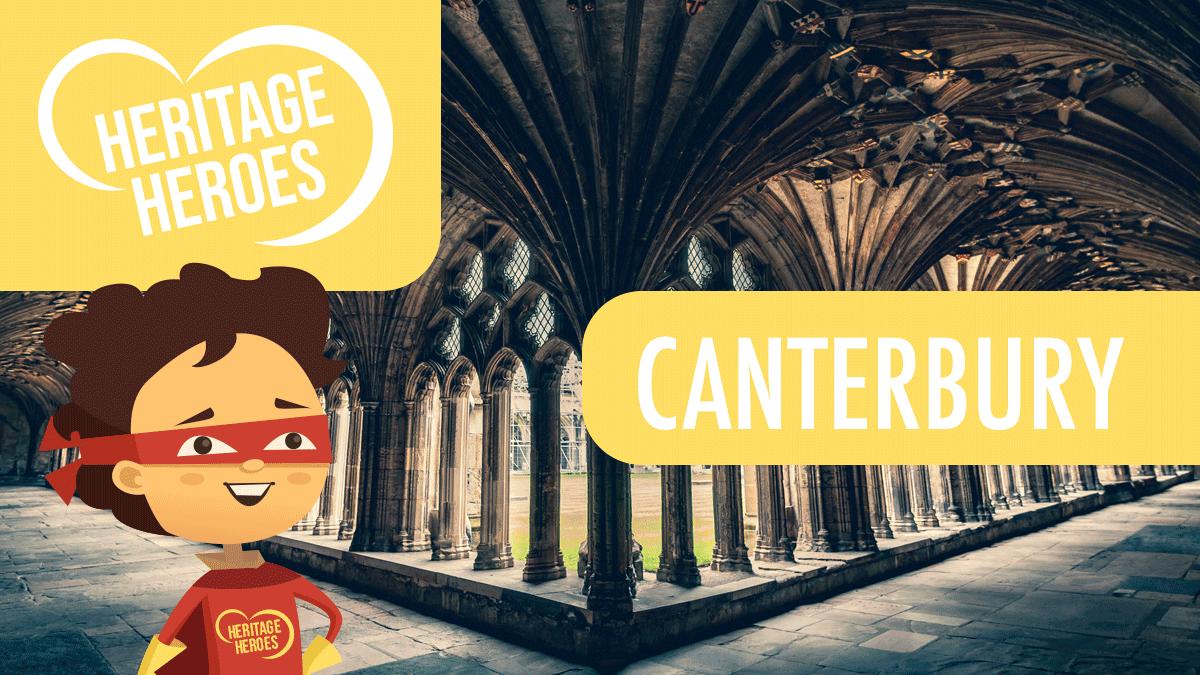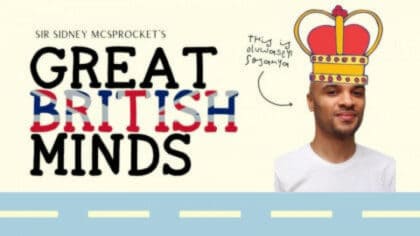Wherever you live, there’s treasure to be discovered! Not just gold and gems, but stories of buildings, locations and people.
Our heritage is a great wealth… and it’s all around us.
Sometimes standing proud in the open air, sometimes hidden behind some bushes.
To help find it, we asked for your help and to become Heritage Heroes.

HERITAGE HEROES. AN INSPIRING AUDIO PRODUCTION FOR FUN KIDS. MADE POSSIBLE WITH THE NATIONAL LOTTERY HERITAGE FUND, WITH THANKS TO NATIONAL LOTTERY PLAYERS.
Canterbury is a cathedral city in the south of England, famous for its resident Archbishop.
Embed from Getty ImagesThere have been 105 Archbishops of Canterbury to date, a long line of succession that goes back to the “Apostle to the English” Augustine of Canterbury, who was sent here by the church in Rome in 597.
Did you know that the Archbishops of Canterbury have crowned almost every British monarch for over a thousand years?
Embed from Getty Images
Canterbury Railway Station
As we arrived by train, where better place to start than at Canterbury West Station!

You told us…
- “I love trains so my pick is Canterbury West Station. It was built in 1846 before Canterbury East station. The design is called stucco which is like very smooth cement. You can even go into the old goods shed which is a market and a restaurant now.“
Railways transformed many towns and cities. They enabled people to travel further for work and pleasure, as well as helping move goods around the country.
As you’ve discovered, Canterbury West wasn’t the first station here. Nearby was the terminus of what was called the Canterbury and Whitstable Railway, which opened in 1830 and was the first railway in the South of England.
Embed from Getty ImagesTwo fun facts are that the line was known as the ‘Crab and Winkle Line’ as it carried a lot of seafood from Whitstable, and the very first season tickets were issued at Canterbury in 1834 – a fact recorded on a plaque at Canterbury West station.
Check it out!
A walk into Canterbury’s history
People have lived here for thousands of years.
There was an Iron Age settlement for a tribe called the Cantiaci, which sounds like it’s reflected in today’s name.
The Roman’s always liked to change the names of places and called it Durovernum Cantiacorum. They also introduced a street grid, public buildings, a forum, temples… oh and some baths.
There would have been stone houses for the affluent and simpler huts for the poor, and a big strong town wall to keep everyone safe.

You can get a glimpse of Canterbury’s roman life at the Roman Museum and even explore parts of a Roman Town house that would originally have been two storeys with mosaic corridors and even an underfloor heating system!

Things went a little quiet when the Romans left, but revival came in 597 with Pope Gregory’s mission, led by Augustine to christianise the Saxons. Augustine established an abbey and slowly Canterbury was reinvigorated with crafts, a mint and a market.

Part of the city’s Anglo-Saxon history can be seen in the Beaney Museum.
Here’s Heritage Heroes Jacob and Isaac to tell us more.…
- “I’m finding out about the golden dragon pendant. It’s made out of gold and it’s like a dragon. It’s tiny and it’s got a loop at the back. It’s got a stone, a garnet stone eye on one side and it’s empty on the other side. It was found in 2013. It sat on the ground for thousands plus years. Some people, very luckily, ten years ago, found it with a metal detector.“
- “I looked at the golden dragon pendant. It looked like a dragon head, about 2cm long. It was found in 2013. It was from the 9th century in Anglo-Saxon times. It didn’t have many scratches or any sort of marks on it. Because it’s a part of history, it’s important to know about it. It was pretty interesting.“
What a find!
By the 9th century, Canterbury had become a substantial settlement but then came the Danes and a period of raids and destruction.
Well, that’s Vikings for you!
With the arrival of the Norman’s, the cathedral was rebuilt in a new style and a stone castle was built.
Embed from Getty ImagesCanterbury became popular for its hospitals for the poor and for a pilgrimage to see Thomas Becket’s shrine after his martyrdom in 1170, as Max found out…
- “Thomas Beckett was murdered after he and King Henry II of England had a big argument about something and he boldly reported that “I wish I could have Thomas Beckett killed” but his knights had misheard him and set off to kill Thomas Beckett. It really shows the emotion that is being shown by Thomas Beckett and the knights. They originally tried to arrest him but he made a struggle and they decided that it would be better to kill him and it really showed the darkness and the evilness from the knights.”
Turbulent times returned in the 16th century, with an influx of Protestants escaping from catholic persecution which was rife across Europe. As well as boosting the population, they brought their distinctive cultures which can still be seen today.
Finally, whilst Henry VIII’s dissolution of monasteries impacted the pilgrimage industry, Canterbury has always remained significant.
Despite being overshadowed by the industrial towns of the north and midlands, Canterbury is full of heritage hotspots.
Memorials and Statues
Memorials are great for helping us explore a place, and find out about the people that live there and important local events.
What you said…
- “I’ve chosen the War Memorial which remembers the men from Canterbury who died in the first world war. Memorials are important because sometimes people died in other countries so they couldn’t have a grave of their own.“
War memorials are a great way for families and friends to remember their loved ones, especially if they died a long way away.
The memorial in Buttermarket was unveiled on 10th October 1921 by a very important man, Field Marshall the Earl Haig, who commanded the British Expeditionary Force on the Western Front from late 1915 until the end of the World War I.

Amongst the names listed is Major Edward ‘Mick’ Mannock who won the Military Cross twice and the Distinguished Service Order three times. He was also awarded a posthumous Victoria Cross, the ultimate military medal.

A great thing about learning about the past in the places we live is that history is all around us. You don’t have to visit a historic manor house or a museum. Although these are great, sometimes you just need to look around, as one of our Heritage Heroes discovered…
- “There’s a really cool telephone box near Canterbury Road that’s really old and I like it because it makes me think about how it must have been really hard before mobile phones and you’d have to go to a box to make a call.“
No mobile phones, no selfies and no emojis… can you imagine?!

You can see these iconic red boxes in many towns and villages, and some still have operating phones.
The one we’ve been hearing about is very special. Its design was called the K6 and it was created by Gilbert Scott in 1935 to celebrate the jubilee of King George V.
They might not be as high tech as our smart phones but can you imagine how kiosks like these might have changed life by helping people to get in touch with relatives and friends or getting help in an emergency.
Now from the humble phone box to something a bit bigger…
Canterbury Cathedral
We’ve arrived at Canterbury Cathedral! It’s over 1,400 years old and is a stunning building with its stained glass windows, towering spires and a fascinating history. It’s one of the oldest Christian structures in England and is home to the most senior bishop in the Church of England.
Embed from Getty ImagesThe Cathedral also has a darker past. It was here that in 1170 the then Archbishop of Canterbury, Thomas Becket, was murdered. Becket used to be close to the King, Henry II, but they fell out over how much power the church should have, and after some knights thought they heard the King say “Will no one rid me of this troublesome priest?” well, they took matters into their own hands.
Becket was made a saint by the Pope following reports of miracles at his tomb and in 1174 King Henry walked barefoot to the Cathedral in penance. The site of Thomas Becket’s martyrdom is marked by a modern sculpture known as the “Martyrdom Window.” It depicts the moment of his assassination and serves as a powerful reminder of his sacrifice.

Also inside the Cathedral is the tomb of a famous medieval writer, Geoffrey Chaucer, who set his literary masterpiece, The Canterbury Tales, in and around the Cathedral. The tales follow a group of pilgrims on their journey to the shrine of Thomas Becket and offers a vivid depiction of medieval life and culture.
Embed from Getty ImagesPilgrims would buy badges to commemorate Thomas Beckett and some of these can be seen at Canterbury’s Beaney Museum.
Here’s what you thought…
- “I looked at the medieval pilgrim badges. Thomas Becket was murdered in 1170. They chopped part of his skull off. People tended to ride horses or walk to his shrine. They would buy badges in the shape of his head. Some of them were square with his head on, other ones were round with his head on. Most of them were intended to be in the shape of his head. I think they’re made of metal and it looks pretty great.”
We’ll find out more about the Beaney Museum later.
As well as looking impressive, places of worship are great at telling us about things. For hundreds of years they were the holders of public records including births, deaths and weddings, so really are time treasure troves.
Marlowe Theatre
Let’s go to somewhere that’s a little more showbiz… Marlowe Theatre!

A Heritage Hero said…
- “I like the Marlowe Theatre. It was built in 1933 and it was named after Christopher Marlowe who was born in 1574 and used to write plays. He was a friend of Shakespeare. It was bombed in the Second World War but has been rebuilt but you can still see the old details on the front.“
For hundreds of years, theatres were the primary places for entertainment.
Whilst they remain popular, the arrival of picture houses, or cinemas to you and me, changed how people were entertained and also got the news. Before television became universally popular in the 1950s, as well as watching films at the cinema, people would also see a short news programme. It was the only way to see moving images of global events.
The Huguenots and the Old Weavers House
You found out earlier about the arrival of many French speaking protestants in the 16th century.
The Huguenots fled here from across Europe due to persecution about their religion. Many were highly skilled in textile weaving, particularly in silk and wool and some of their historic houses still exist today. Let’s take a look!

The Old Weavers House is on the High Street. Although dated as 1500, much of the buildings’ structure is older and the foundations were laid in the 12th century.
It’s a distinctive building with black and white half-timbered with a high-pitched roof and tall windows.
Weaving houses were designed to have both living space and workshops. The looms would have been on the ground floor, and the closeness to the river would have helped the weavers access materials, water and the markets.

The Huguenots played a crucial role in developing the city’s weaving industry, bringing huge economic benefits to Canterbury. Although over time many moved to Spitalfields in London, and by 1837 Canterbury weaving had pretty much ceased entirely.
Immigration has been part of our country’s fabric for millennia. Can you think of parts of your town’s culture that have come from other countries?
From homes to medieval towers, we’re off to…
Westgate Towers
The Westgate Towers are the only remaining medieval entrances into the city of Canterbury.
Embed from Getty ImagesThey were built in the late 14th century and played a crucial role in controlling access to the city and to collect tolls from those entering! They’re testament to the city’s historical fortifications and defensive system and tell us how it would have defended itself.
If you climb to the top of the tower, you’ll have a fantastic view over Canterbury’s rooftops. Check out the old cannons! They’re not loaded, but still look mighty impressive!
As well as defending to city, the upper floor of the towers housed a jail.
You might want to think about why city gates fell out of use and why we don’t build them any more. What might have changed?
Canterbury Castle
Next up another medieval monument – Canterbury Castle.
Embed from Getty ImagesHere’s what you found out…
- “We looked online and discovered that the castle was built in the 11th century to protect the city from invaders. Knights would have had jousting competitions here.“
Unfortunately it’s not been possible to visit the castle ruins since 2018 as they’re not safe to explore, so here’s a bit of heritage background…
The Castle was used as a royal residence when monarchs visited Canterbury.
During the 13th century, the castle was involved in the Great Siege of Canterbury and was captured by a group of rebels known as the Barons of the Cinque Ports.
Embed from Getty ImagesWhile it’s in ruins today, the remains of the towers and walls give us a glimpse into the castle’s past grandeur and its defensive capabilities.
Fun fact: There were secret passages and tunnels around the castle which allowed people to move around discreetly.
It’s a shame that we cant currently explore the ruins, but you can see why it’s important to look after our heritage. Some of it can fall into disrepair or disappear altogether.
Dane John Gardens
Next up, somewhere you CAN walk in the footsteps of our forebears! It’s Dane John Gardens.

The park was created in the early 19th century, before which, it had quite an interesting history.
The name Dane John is a corruption of the Norman word ‘Donjon’ meaning a fortified mound. The Romans built their city wall to incorporate the ancient mound, and the Normans later built their first castle on top of the mound. Today, there’s a monument on the top of the mound to commemorate Alderman James Simmons’ gift of the gardens to the people of Canterbury.

Another memorial commemorates the many members of the local regiment, The Buffs, who lost their lives in the Boer War.
Today the gardens are a popular spot for leisurely walks and picnics, and check out the bandstand that’s used for traditional concerts in the summer. It’s a replica of the old Victorian one built here.

During World War II, Canterbury suffered extensive bombing raids, and the gardens and the surrounding area were heavily damaged, including the original bandstand.
The gardens were restored after the war. It’s an interesting pick because it tells us about life in Victorian times when they built urban parks to promenade and get away from the bustle of town life.
The Beaney House of Art and Knowledge
Another great place to learn about local history are museums, and we’re finishing our Heritage Hero visit to Canterbury at The Beaney House of Art and Knowledge on the High Street.

We caught up with lots of you who told us about your favourite finds…
- “I looked at a teddy bear which someone had in World War II when they evacuated. It was jointed so it could move its arms and legs. It had orange and black glass eyes and it had lost quite a lot of its fur. You could see patches of the fabric through it. Because it’s old and it’s had a lot of value when the person was using it, it probably comforted the person a lot.“
- “Charlie the Bull makes me feel happy because he’s with all the other bulls and it’s so big that they had to cut it in half to get it in. He’s got lots of patches of white all over him. It’s a really big bull! The other bulls are just completely brown. It’s really beautiful and really big and I think it took a really long time to paint.“
- “I found a picture of a bull. I like this picture because I like the detail, I like the background. The has some some dusty ground and very detailed clouds. It’s bigger than me. Daddy, it’s bigger than you.“
- “Bagpuss is a cat in a film and they actually accidentally dyed him the wrong colour. He was supposed to come out orangey yellow but they accidentally put him in the wrong dye so he came out pink. It was a TV series on the BBC. It’s different to what we do now. I looked at The Clangers. They’re like these little weird alien type things and they’re set on outer space, like in the moon and stuff they started, they did it in Bleem Studio, outside of Canterbury. It was originally a cow shed but then they moved into a pig shed.“
- “Rupert Bear was created as a cartoon for the Daily Express by Canterbury artist, Mary Tourtel, in 1920. He wears yellow checks, trousers and scarf. He is a white bear and has friends who are different animals, Bill Badger, Algy Pug, Edward Trunk, Podgy Pig and the Wise Old Goat.“
- “I saw the mammoth tusk. It was way bigger than I thought it was going to be. It did look very old as well. It had a pretty intense curve, not going to lie. It was like a yellowy white.“
- “I’m going to talk about mummified cats. Did you know that the Egyptians worshipped cats so when they died Egyptians made them into mummies? Loads of cats were buried where there were cat cemeteries. Here they worshipped the cat goddess Bastet. Some cats faces can still be seen. To mummify a cat you have to pull out all its insides and fill them with earth and sand. Disgusting! Then it would be wrapped in bandage soaked in salt or a sticky substance called resin. The cat’s legs were tucked in so they looked like a tube in bandage. Did you know that during the Victorian times the cats were grounded into pulp for medicine? Disgusting!“
- “I saw a small ammonite. My favourite thing about it was that it had sparkles inside, it was sort of turquoise and then it went to a sort of goldish colour and then it went black and there were no longer sparkles. I think it’s 145 million years old.“
- “So it was 300 million years ago. This fern was once part of a vast tropical wetland known as a coal forest, which was buried in mud. Further layers of sedimentary were deposited on the top and this mud slowly turned into shore rock and the ferns left an imprint in the form of this fossil. Well, I didn’t know that plants could be a fossil. I thought it was just animals, because quite often you see the old dinosaur age fossils, but no, plants can be a fossil too.“
Back to the present day and I hope you’ve seen how the past really is all around us, our heritage telling us the story of the places we live.
We’ve had a great time exploring Canterbury. Thank you for joining us! There’s plenty more to explore here and across the country – wherever you live.
Don’t forget to go online to find out more about how to explore and record heritage in your area and of course, download your Heritage Hero certificate here.
Join us again to explore some more local heritage highlights and hotspots.









